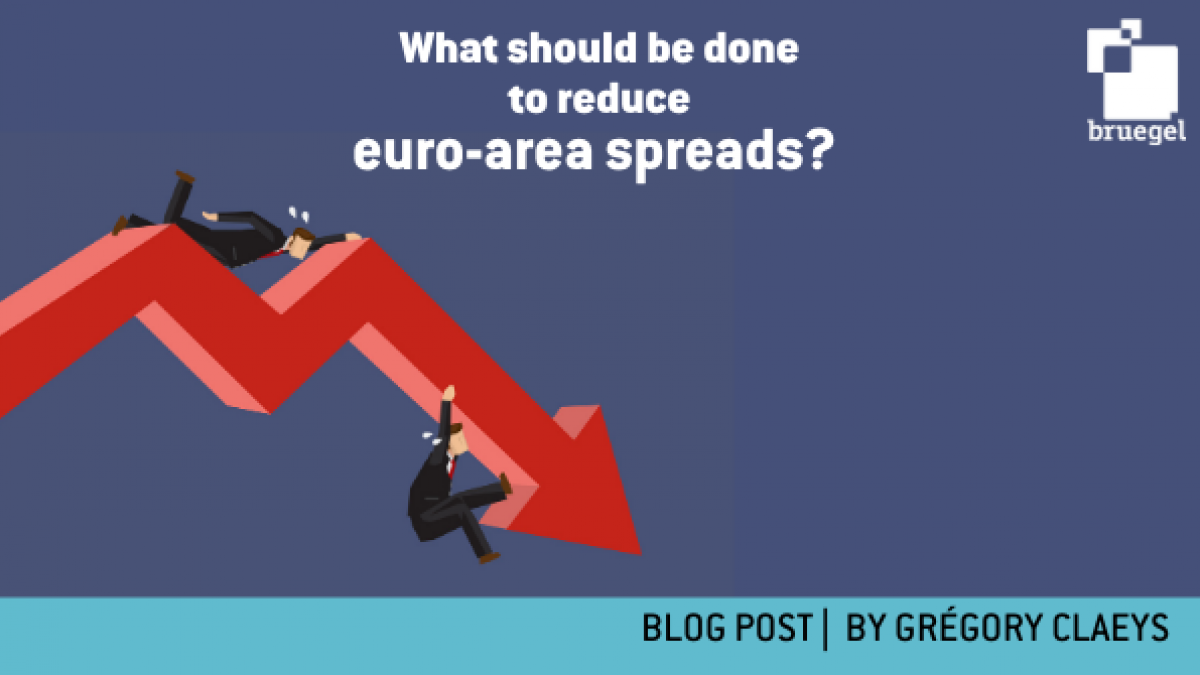What should be done to reduce euro-area spreads?
Spreads are rising again in the euro-area at the worst possible time, when fiscal policy is needed to fight the coronavirus pandemic and the related e

As a result of an unfortunate declaration by European Central Bank President Christine Lagarde during the bank’s 12 March press conference that “we are not here to close spreads”, Italian yields have increased significantly in recent days. Despite ECB backpedalling[1], the spread with the German yield quickly reached the level prevailing during the 2018-2019 Five Star-Lega coalition, when the redenomination risk was considered high by markets (ie between 250 and 290 basis points, see Figure 1).
The ECB communication blunder thus created some real doubt among market participants about the readiness of the ECB to honour its promise to do “whatever it takes” to safeguard the euro area and to ensure the adequate transmission of monetary policy in all countries. Italian spreads have not abated and the weighted average of euro-area yields has even continued to increase in the last few days.
Given the current situation and the need to use fiscal policy as the main response to the coronavirus crisis – to address the health situation and to put in place a massive stimulus to dampen the substantial related economic shock – euro-area governments must be able to continue to access markets easily and cheaply[2].
For that to happen, the ECB must be ready to provide a backstop to its member states. What options do European policymakers have to deal with this vital issue?
1. Massively increase Quantitative Easing
Using the ECB’s QE programme is probably the best and most logical option to deal with a shock that is fully exogeneous and will soon become fully symmetric as the coronavirus spreads quickly in the euro area (as already argued by some of my Bruegel colleagues).
The ECB announced on 12 March an increase in asset purchases by €120 billion up to the end of the year, in addition to the €20 billion per month decided in September 2019. Furthermore, when the spreads started rising, the ECB quickly highlighted that the additional envelope could be used flexibly from a geographical perspective (at least in the short term[3]), in terms of pace and asset composition[4] (even though the introductory statement at the 12 March press conference clearly suggested that the envelope was originally supposed to be used for the private-sector asset-purchase programmes, ie for corporate bonds, ABS and covered bonds).
Now that markets are testing the ECB’s 2012 “whatever it takes” promise, it is probable that the measures announced on 12 March will not be enough and the ECB will have to intervene much more substantially[5]. The €300 billion in asset purchases planned before the end of the year will not be enough to deal with a widening of spreads, especially if we end up with a movement similar to that seen during the euro crisis.
A quick announcement of a massive increase in asset purchases – for example, of the equivalent of 10% of euro-area GDP per year, or €1.2 trillion – could possibly do the trick and calm markets, as it would represent a significant share of the euro-area sovereign debt not held yet by the Eurosystem (approximately €8 trillion).
To increase significantly the volume of asset purchases, the ECB will have to review urgently its self-imposed issuer limit. Otherwise, purchases would have to be stopped relatively quickly (or the ECB will have to deviate significantly from capital keys, which appears to be politically more delicate for the QE programme). A first solution, which would constitute a strong and welcome signal for market participants, would thus be to relax immediately the 33% issuer limit in order to allow QE to be used to deal with the current situation.
This should legally be possible. In its 2018 judgement on QE, the EU Court of Justice seemed to consider that in theory the relevant limit of the ECB’s public-sector purchase programme compatible with the EU Treaty is not to buy all the bonds issued. Indeed, it stated that the European System of Central Banks (ESCB) is “not permitted to buy either all the bonds issued by such an issuer or the entirety of a given issue of those bonds” and that monetary financing is avoided when “a private operator necessarily runs the risk of not being able to resell them to the ESCB on the secondary markets, as a purchase of all the bonds issued is in all cases precluded”.
However, if the 2008-2015 period taught us one important lesson, it is that the more the ECB waits, the bigger its ‘bazooka’ will have to be. This means that, if the ECB does not act very quickly with QE, it could be necessary for the ECB, relatively soon, to announce unlimited purchases to bring down yields and restore the monetary transmission channel.
The ECB’s Governing Council might find it difficult to accept that its QE programme should be unlimited, or that there should be significant deviation from the capital key allocation. It might thus prefer to use another major tool introduced in 2012 to deal specifically with abnormal spreads: the OMT programme.
2. Use the Outright Monetary Transactions (OMT) programme
This tool was designed in 2012 to deliver on President Draghi’s promise to do “whatever it takes” to safeguard the euro area, within the ECB’s mandate. Given the difficulty of distinguishing between solvency and liquidity crises and the desire to avoid moral hazard, it was decided by the ECB that the OMT programme would be conditional on the participation in a European Stability Mechanism programme of countries benefitting from OMT. The main reason was that the ESM board (composed of euro-area finance ministers) would provide the political validation of the debt sustainability necessary for the ECB to act, while the ESM programme itself – formalised in a Memorandum of Understanding (MoU) – would ensure that sound fiscal policies would be put in place in the future. This distribution of roles between the ESM and the ECB was supposed to solve the inherent fragility of sovereign debt in the economic and monetary union, which arises because of the Treaty prohibition of monetary financing.
However, the current situation is totally different from 2012: as the current shock is perfectly exogenous, moral hazard is not part of the issue and should shape neither the debate nor the policy response. The sound policy today from a humanitarian and a debt sustainability perspective is for fiscal policy to be fully unconstrained to fight the health and economic crisis. In the current situation, an ESM programme, and thus the OMT, should come with no conditionality or, at least, with as little conditionality as possible.
A first possibility would be for the ECB to revise the technical features of OMT contained in the 2012 press release. This would represent a radical change to the OMT tool, as it would alter the delicate balance of power between the ECB and the euro-area finance ministers reached in its original version. Nevertheless, the Governing Council has full discretion over this tool and could thus act as long as it believes it is within its mandate (and that it cannot be challenged successfully in courts at a later stage).
If in the end the Governing Council is reluctant to modify significantly this key instrument, it will be necessary to resort to an ESM programme to access it. What kind of ESM programme could be used to activate OMT as soon as possible?
Via an ESM Precautionary Conditioned Credit Line (PCCL)
The most obvious ESM instrument to deal with abnormal spreads is the PCCL. This precautionary credit line can be granted to all countries that want to have the possibility to access ESM assistance before they face major difficulties raising funds on the capital markets. Access is given based on pre-established criteria and a commitment to continue to adhere to these criteria in the future.
Fortunately, the ill-conceived planned reform of the PCCL, which would have made most euro-area countries ineligible because of tighter quantitative conditions, has not yet been enacted. The current conditions to access a PCCL could easily be considered as fulfilled for most euro-area countries in the current situation[6].
However, there are two caveats. First, it is not totally clear if being eligible for an ESM PCCL would be sufficient to be considered eligible for the ECB’s OMT programme. The ECB’s OMT press release is rather ambiguous on that matter. The ECB’s guidelines state that the OMT is conditional on an ESM programme and that “such programmes can take the form of a full EFSF/ESM macroeconomic adjustment programme or a precautionary programme (Enhanced Conditions Credit Line), provided that they include the possibility of EFSF/ESM primary market purchases”. The ECB thus mentions explicitly precautionary programmes (which include the PCCL) and primary market purchases (which are possible under PCCL), but it also singles out the Enhanced Conditions Credit Line. It is difficult to know if this is meant to be an example of a precautionary programme or if it is intended to exclude the PCCL. To the best of my knowledge, there is no other ECB document or any speech by the members of the Governing Council clarifying this essential question.
The ECB should thus clarify as quickly as possible its 2012 OMT press release and say if a PCCL can be considered sufficient as a pre-condition to activate an OMT programme (which should be the case in my view).
The second caveat is that, despite its pre-established eligibility criteria, a PCCL is still conditional on the signature of an MoU. This could allow other countries to attach all sorts of policy conditions to it (we will return to this problem below).
Via an ESM Enhanced Conditions Credit Line (ECCL)
If the ECB does not provide clarity about the PCCL, or if it considers that the PCCL is insufficient to access OMT, the other solution is to use the ECCL explicitly mentioned in the original ECB OMT press release.
As explained by the ESM guidelines, an ECCL is the other form of precautionary credit line offered by the ESM. It is open to all euro-area countries whose economic and financial situation remains sound, but that do not comply with the eligibility criteria for PCCL. In that case, the MoU is, in theory, supposed to be more detailed and conditions more stringent, because countries that do not comply with all of the eligibility criteria of the PCCL should address these potential weaknesses.
However, given the exceptional nature of the current crisis (and whether a PCCL or an ECCL is used) an ESM programme MoU could only contain the following statement, as argued for instance by Blanchard: “spend what you must on crisis containment and commit to wind down everything once the crisis is over”. This would be perfectly compatible with the spirit of the precautionary credit lines of the ESM.
A collective application for an ESM precautionary credit line
In any case, there is one remaining, and very significant, problem with the idea of using the ESM/OMT option to deal with the current situation. The mere mention of an ESM programme and of a MoU (which at this stage would have to be signed in both the PCCL and ECCL cases) is politically toxic in countries such as Italy (as the heated debate about the ESM reform a few months ago showed).
This is because, after the Greek experience, mention of ESM and MoU has become synonymous with austerity and loss of sovereignty for many people in southern Europe. Whether this reputation is deserved or not, the result is that it would be politically difficult, if not impossible, for some governments to sign up to an ESM programme at this stage.
One way to avoid this stigma would be for all euro-area countries to agree to apply collectively and simultaneously for an ESM PCCL (or for an ECCL if the PCCL is not possible), with the same minimalistic MoU discussed above for all countries.
Given the size of the shock that is coming for the whole euro area, it would anyway be in the best interest of all countries to insure themselves against a potential bad equilibrium in which they would lose market access during the coronavirus crisis. Even if, today, some countries consider that the probability of such an event is very low for them, it is crucial to be sure to avoid it, because its impact would be devastating for any country, were it to happen in the midst of a health crisis.
3. The pros and cons of the various options
Overall, the easiest and quickest path to tackle the current sharp spike in intra-euro-area spreads, which is threatening the policy response to the health and economic crisis, would be for the ECB to increase massively the size of its QE programme (let’s say by €1,2 trillion by the end of the year) and to use all the flexibility available under the programme – in terms of capital keys in particular, which is possible at least in the short term. For this to work, it needs to be announced as soon as possible.
If the ECB does not act fast enough, it might quickly have to use a more powerful and unlimited tool: the never-implemented OMT programme. To implement this quickly, a first possibility would be for the ECB to waive the requirement for a country to be part of an ESM programme to access OMT. This solution would be highly effective and should calm the markets immediately. However, this would constitute a radical change of the tool that the ECB Governing Council might not be ready to do at this stage, as it would alter the subtle balance reached in the original version of the OMT.
In that case, the other option would be for countries to enter an ESM programme, but to do so in a way that involves as little conditionality as possible. The best way – and probably the only at this stage given how toxic the mention of an ESM programme has become in some countries – would be for all euro-area members to collectively apply for an ESM precautionary credit line, with the same conditions. Such a coordinated move, coupled with a quick ECB decision to launch OMT programmes focused on the sovereign debt securities that are currently under pressure, should be highly effective in lowering spreads to their pre-crisis levels.
Of course, agreeing quickly in the Eurogroup and in the European Council on such a plan is probably more difficult politically than waiting for the ECB to save the day, as has been the case in the past – in 2012 with Draghi’s “whatever it takes” and in 2015 with QE. But this ambitious solution would have the clear advantage of letting elected policymakers finally take control of Europe’s destiny while showing some unity and a sense of solidarity in these dire times.
[1] By Lagarde herself in an ensuing interview, but also by Executive Board members Lane, Panetta, and Schnabel and by a few other members of the ECB’s governing council
[2] Another possibility (not explored in this blog post) would be to fully mutualise the expenditures devoted to the current crisis at the European level and finance them through the issuance of dedicated common debt instruments, ie ‘corona-bonds’.
[3] Executive Board Member Lane wrote that: “deviations from the steady-state cross-country allocation are within the remit of the programme, so long as the capital key continues to anchor the total stock of our holdings in the long run.”
[4] Executive Board Member Panetta declared that: “The package of measures that we adopted this week allows us to act flexibly in terms of both the pace and the composition of our asset purchases, meaning that we have the possibility to focus our efforts on asset classes and countries that come under pressure.”
[5] As a comparison, the volume of asset purchases announced by the Fed on 15 March was much more significant: “To support the smooth functioning of markets for Treasury securities and agency mortgage-backed securities that are central to the flow of credit to households and businesses, over coming months the Committee will increase its holdings of Treasury securities by at least $500 billion and its holdings of agency mortgage-backed securities by at least $200 billion.”
[6] The current PCCL criteria are: compliance with the fiscal rules, even if a country is subject to an Excessive Deficit Procedure, as long as the country follows the Council’s decisions and recommendations; a sustainable government debt; compliance with the requirements of the Macroeconomic Imbalances Procedure, even if a country is subject to an Excessive Imbalances Procedure; a track record of access to capital markets on reasonable terms; a sustainable external position; and no systemically relevant bank solvency problems.



